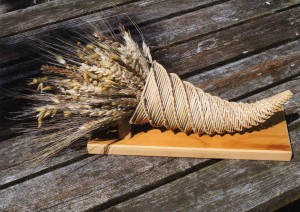 Corn dollies are a form of straw work made for, and associated with, harvest customs before the age of mechanisation. One source places the origin of corn dollies back to Pagan times in European culture before the spread of Christianity. Whatever the source, the corn dollies were significant in terms of the harvest of crops until relatively recently and centred around the “Spirit of the Corn”. There were a wider variety of names and terms such as “Corn Mother” and “Corn Maiden” but essentially it was the spirit of the crop that lived in the crop until it was harvested. Then came the problem of where the spirit would stay during the winter. Accordingly the last sheaf of the harvest would be made into a corn dolly. This would represent and contain the spirit of the harvest and it would spend the winter in a house or other building. It would then be ploughed into the first furrow to be turned the next year and so the spirit of the corn lived on and on.
Corn dollies are a form of straw work made for, and associated with, harvest customs before the age of mechanisation. One source places the origin of corn dollies back to Pagan times in European culture before the spread of Christianity. Whatever the source, the corn dollies were significant in terms of the harvest of crops until relatively recently and centred around the “Spirit of the Corn”. There were a wider variety of names and terms such as “Corn Mother” and “Corn Maiden” but essentially it was the spirit of the crop that lived in the crop until it was harvested. Then came the problem of where the spirit would stay during the winter. Accordingly the last sheaf of the harvest would be made into a corn dolly. This would represent and contain the spirit of the harvest and it would spend the winter in a house or other building. It would then be ploughed into the first furrow to be turned the next year and so the spirit of the corn lived on and on.
Needless to say there were many variations with some of the corn dollies being quite basic whilst others were elaborate such as the one termed a “Cornucopia” as shown in the photograph. Some were dressed in women’s clothes and called the Corn Mother. With so little communication and transport, sometimes non existent, between the settlements and villages, individual corn dollies came into being . Some represented areas whilst others could even represent a small village or settlement of varying description and size. What happened to the corn dolly at the beginning of the next harvest varied. Most of them were ploughed into the first furrow whilst others were given to the first horses to be used so that they could eat them before the ploughing started. Others were just trampled into the ground by people. Whatever the custom it was essential that the corn spirit lived on and thus there would be another harvest.
There were many spin offs such as much smaller corn dollies being made to act as good luck charms. There was one significant one in the form of love charms. One of these was widespread and known as “A Countryman’s favour”. It was often made of a plait of three straws and tied into a loose shape to look like a heart. It was made by young men with stems picked up after the harvest and given to their loved ones. If she was wearing it next to her heart when he saw her again it showed that his love was reciprocated. Even the material used varied, as in Great Britain it was mainly wheat, oats and barley. In Ireland it was rush whilst in southern France it was palm leaves.
All this interest in corn dollies led to the increasing use of them as good luck charms in houses. Indeed we have a corn dolly in every room in the house with this good luck idea in mind. However, my latest acquisition is a much bolder and old fashioned work in the “Cornucopia” shown in the photograph. This is an impressive corn dolly by any standards as it is sixteen inches long and eight inches high and on a specially made wooden base. The origin of this ancient design of corn dolly is supposed to have been traced back to Greek mythology involving Zeus and his mother. It represents the horn of plenty and filled with various crops such as grasses, wheat and oats indicating a bumper harvest. In this case the corn dolly was made by the only extant corn dolly maker I can find in Scotland, let alone the Highlands. She is Elaine Lindsay living in Aberdeenshire. For more information on her excellent work go online to www.somethingcorny.co.uk.
